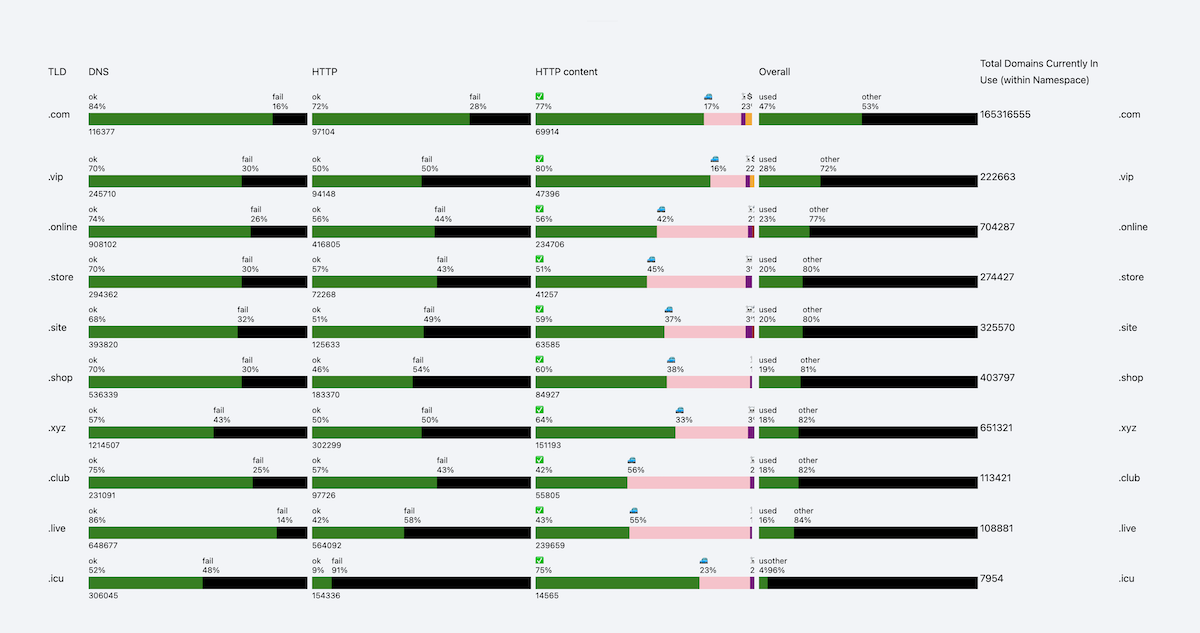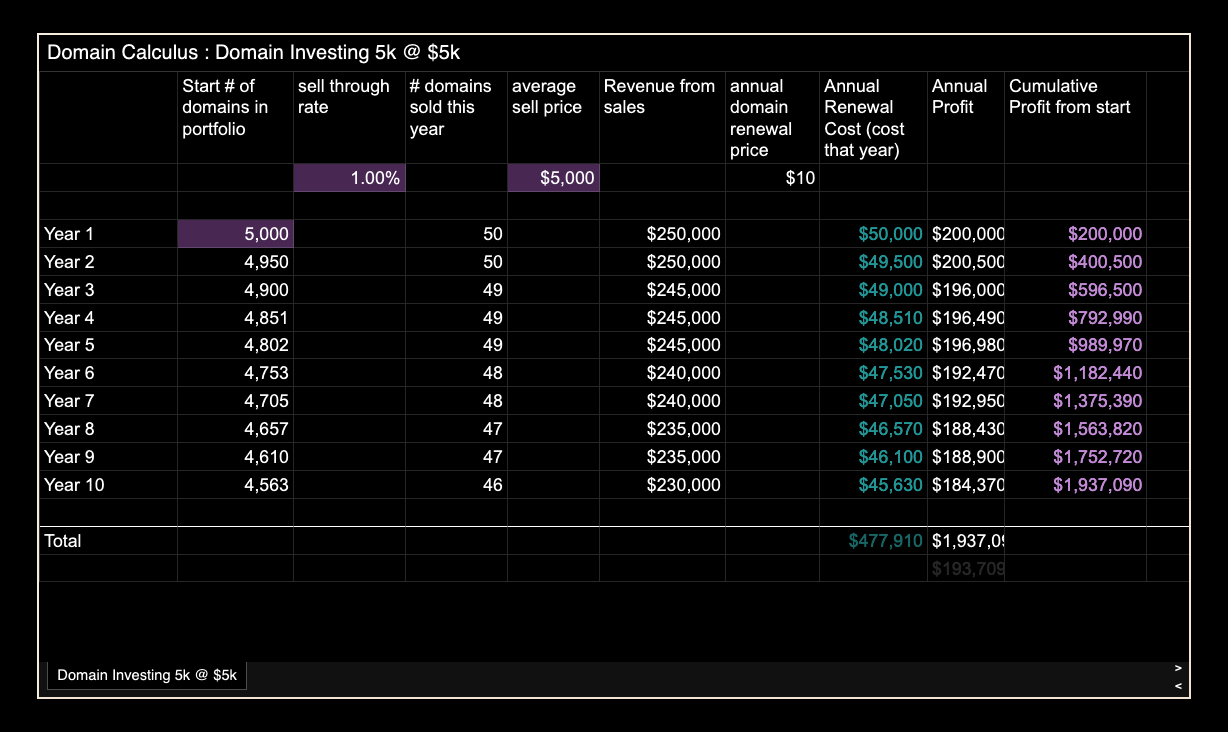Why are domain names so expensive?
June 13, 2023Ever since dipping my feet into the domain industry a few months ago, I have been learning from the industry leaders, trying to find where we fit. One of the goals I had while building Smartynames was to make domains more accessible, and we did just that, first by making it easy to generate new and available names, and then by releasing a daily list of domains available for sale today. But through this whole process, one question kept popping up - if we can generate domains that sell for 10 bucks, then why are domains that are already taken sell for so much more? I might have an answer.
TLDR: Most domain investors lose a lot of money on 99% of their domains, so in order to turn a profit, the domains they sell have to be sold at a premium. And the key here is that they have to, otherwise the business would not make any financial sense. I will show you in the tables below why that is the case.
For the sake of simplicity, we will assume a very basic model **. Costs of doing business in real life are even higher, but this simple model will make a point.
Imagine for a moment that you are a domain investor.
Your goal is to buy domains low, keep them for a while, and then sell high to a willing buyer. For example, you might have bought a GPT-related domain before ChatGPT or AI got popular, and then you sold it for profit to anyone wanting something with GPT in it. Doing this one time makes you lucky, but it does not make you an investor. Investors buy in bulk and make their living trading domains. Here is how it might work.
Let us say you bought 50 domains that you think are really good. They are either brandable, or premium, or short. Something in your gut, or in your domain name search tells you that your domains are gold and there will be someone looking for just the right name, and you have it. Now what?
If you like Excel tables, clone this spreadsheet so you could play with it yourself.
Now you realize that you just spent $500 ($10 * 50 domains) to buy these domains, and you want your money back! So what do you do? You list your domains for sale! You list them for $500 each, and you wait; and wait, and wait, and you realize that a typical sell-through rate is just 1%, and that is considered good. You are in for a surprise! All you can expect from your investment of 50 domains is that 1 of them sells each year, and that is a best case scenario, if we round up. The odds are not in your favor.
Lucky you, one of your domains sells for $500. You have now paid back your investment. $500 was spent to buy your portfolio of names, you have just earned $500 for selling one. Unfortunately, you have not made any profit, and the year is now over, and it’s time to pay to renew your remaining domains. The cost of renewal is $490.
Year two goes by, and you make another sale. $500 into your pocket, minus the $490. You made $10 this year. You are a rockstar! At this rate of return, you have lost your house, your partner has divorced you, and you are living under a bridge in a cardboard box. Not good. What can you do to make millions and retire in a big house somewherein in Miami instead?
The simple answer is that you have to charge a lot more, and you have to hold more domains because when you multiply the constant sell-through rate by a higher number, you get a higher return. You can play with the excel spreadsheet to try various scenarios, but here are some quick examples.
If you sell each domain for $5,000, you can make $45,000 over 10 years. If you hold a portfolio of 500 domains, you can make 200k in that time. And if you hold 5000 domains, you will make $1.9 million over that timeframe.
As you can probably see by now, it simply does not make sense to have a portfolio of domains and to sell them for cheap.
Domain investors are not mean people, and they are not trying to hoard domains for pleasure. They are trying to make a living, like the rest of us. Many of them may not have even realized the game dynamics, until they were in it.
The only way they would sell those domains for less, given this model, is if the sell-through rate could go up. There is a possibility that by lowering a price of domains in a portfolio, the overall number of domains sold would go up, yielding a higher net return. We don't know whether people who turn away at a $5k price tag, for example, would buy at $1.8k. To test this theory requires convincing someone with a large portfolio to drop their prices, and given their livelihood depends on the income, it is a difficult ask. As long as there are some willing buyers to pay premium prices, there is no forcing function to sell for less.
This does not mean you have to buy expensive domains. You can still search for domains that are available at a lesser price. But if you happen to find a name that you really love, and it is available for sale via a broker, hopefully you will not be surprised that it might cost an arm and a leg.
Domain investing is a business, and businesses need to make money, or they go kaboom.
If you are looking to buy and sell domains professionally and have questions, email `hello` at smartynames with details. Let's see what we could do together.
p.s. As my good friend Rafal pointed out, the cost of holding a domain forever*** is actually much greater in present dollars than simply the cost of renewing that domains for a few years.
** For the sake of the argument, we will assume things are simpler than they are in real life.(1) All the domains in our portfolio cost $10 to buy, and $10 to renew each year. In practice, costs vary, but they mostly go up, and not down. (2) We will not account for time value of money, and the fact that domains sold today have to sell for substantially more, in order to cover the holding costs of domains sold in the future. (3) We will not replenish domains over time. The model starts with X domains in portfolio, and diminishes over ten years. (4) We will forgo 15%-30% commission to the broker (GoDaddy at el) that you have to pay on mostly every sale.(5) This model assumes an average portfolio of probably somewhat decent domains. People who bought amazing one-word domains in the 90s and are selling those for hundreds of thousands are outliers, and their portfolio is no longer accessible to new players.
*** Cost of owning something forever, explained by ChatGPT.


